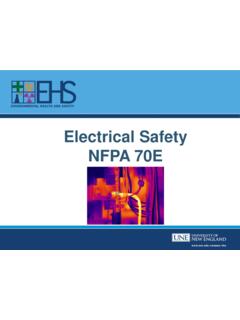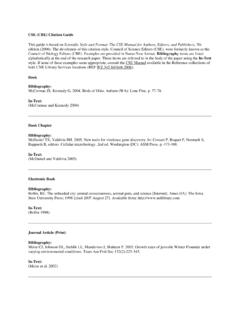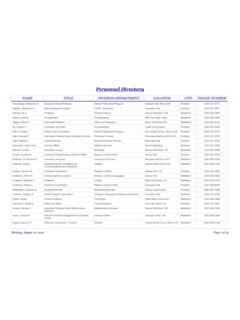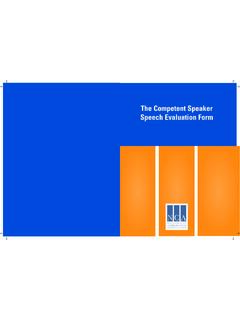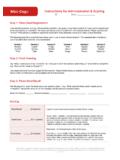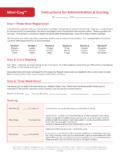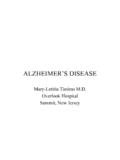Transcription of THE MEDICARE ANNUAL WELLNESS VISIT: RECOMMENDED …
1 THE MEDICARE ANNUAL WELLNESS VISIT: RECOMMENDED SCREENING TOOLS Charlotte A. Paolini, D. O. University of New England Maine Geriatric Education Center June, 2015 Disclosure Declaration I have no actual or potential conflict of interest in relation to this program or presentation. GOALS OF PRESENTATION: To provide the clinician with easy-to-use, appropriate screening tools for assessing geriatric patients at the initial and ANNUAL MEDICARE WELLNESS visits for: DEPRESSION FUNCTIONAL ABILITY COGNITION OBJECTIVES At the end of this presentation: 1. The student will be able to understand the difference in the Assessment components for the Initial and ANNUAL MEDICARE WELLNESS Visits. 2. The student will be able to administer, score, and interpret the clinical significance of specific geriatric screening tools for: Depression Functional Ability Cognition MEDICARE ANNUAL WELLNESS VISIT (AWV) The purpose of the ANNUAL WELLNESS Visit (AWV) is to help MEDICARE patients in maintaining health and preventing or slowing chronic disease processes along with encouraging healthy lifestyle habits.
2 COMPONENTS OF THE AWV 3 components of the AWV: 1. History: PMH, PSH, medications and supplements, list of current providers, FH 2. Patient Assessment: Ht., Wt., BMI, BP, Cognitive evaluation, Depression screening, Functional ability 3. Orders or Counseling: Written RECOMMENDED screening schedule, list of RF/conditions w/ interventions, personalized health advice, voluntary advance care planning. Initial AWV Requirements: Must have been enrolled in MEDICARE for >12 months Must NOT have had their Welcome to MEDICARE Physical (IPPE) service within the past 12 months History component must contain a completed Health Risk Assessment Complete medical history Complete list of medications and supplements Current list of all medical providers Family history Initial AWV cont. Patient Assessment: Screening Tests for: Depression Functional Ability IADLs Home Safety Fall Risk Cognition Blood Pressure, Height, Weight, BMI Initial AWV cont.
3 Orders and counseling Personalized written schedule for covered health screening services and immunizations A written list of the conditions and risk factors for which treatment is being RECOMMENDED to them Personalized health advice based on the patient s age and health status Voluntary Advanced Care Planning Written or verbal information about preparing an advance directive if the patient is receptive Subsequent AWV Requirements Must have already had an initial AWV and be 11 full months after a previous AWV Essentially updates all historical information obtained during the initial AWV or previous AWV: Update the HRA Update medical and family histories Update medications and supplements Update provider list Subsequent AWV cont. Patient Assessment: Blood Pressure, Weight Cognition Orders and counseling: Update the written screening schedule from the prior AWV Update the written list of conditions, risk factors, treatments, and RECOMMENDED interventions Personalized health advice as appropriate Voluntary Advanced Care Planning: Review and update as per the patient s wishes Screening Tools for the AWV There is no particular screening instrument recognized by CMS for use in the AWV, so the provider may choose to use any screening tool as long as it is a nationally recognized instrument.
4 Specific Screening Tools Depression Screening: PHQ 2 PHQ 9 Functional Ability: Timed Up and Go (TUG) IADLs Cognition: MiniCog Memory Impairment Screen (MIS) General Practitioner Assessment of Cognition (GPCOG) Depression Screening The Patient Health Questionnaire-2: PHQ-2 Overview Used as an initial screen for depression Inquires about the frequency of anhedonia and depressed mood over the past 2 weeks Includes the first two items of the PHQ-9 A PHQ-2 score ranges from 0 6 A score of 3 is the optimal cut point for screening purposes and warrants further evaluation A positive screen should be further evaluated with the PHQ-9 to determine whether the patient meets criteria for a depressive disorder PHQ - 2 Over the past two weeks, how often have you been bothered by any of the following problems? 1. Little interest or pleasure in doing things. 0 = Not at all 1 = Several days 2 = More than half the days 3 = Nearly every day 2.
5 Feeling down, depressed, or hopeless. 0 = Not at all 1 = Several days 2 = More than half the days 3 = Nearly every day Total point score: _____ Depression Screening The Patient Health Questionnaire-9: PHQ-9 Overview Administered to patients with a positive stage-one screen (PHQ-2) An excellent questionnaire for confirming the diagnosis of major depressive episode Two-stage screening with the point-scored PHQ-2 as the initial screening instrument and the PHQ-9 for confirmation of a major depressive episode yields accurate overall results ( ) Can also be used to monitor the severity of depressive symptoms and assess response to treatment PHQ - 9 PHQ 9 (cont.) NOT AT ALL SEVERAL DAYS > HALF THE DAYS NEARLY EVERYDAY PHQ 9 Interpretation Interpretation of Total Score Total Score Depression Severity 1-4 Minimal depression 5-9 Mild depression 10-14 Moderate depression 15-19 Moderately severe depression 20-27 Severe depression Functional Ability Determines the ability of the older adult to remain independent Multi-factorial Often modifiable ANNUAL screening is appropriate and helpful in older
6 Adults after the age of 65 Screen for Falls and/or Fall Risk Key Falls Questions: 1. Did you fall within the last year? If YES , ask: How many times? Were you injured? 2. Do you feel unsteady when standing or walking? 3. Do you worry about falling? If the patient answers YES to any key question, evaluate gait, strength, and balance. Timed Up and Go (TUG) Purpose: To assess mobility Equipment: A stopwatch Directions: Patients wear their regular footwear and can use a walking aid if needed. Begin by having the patient sit back in a standard arm chair and identify a line 3 meters or 10 feet away on the floor. Instructions to the patient: When I say Go, I want you to: Stand up from the chair Walk to the line on the floor at your normal pace Turn Walk back to the chair at your normal pace Sit down again On the word Go begin timing. Stop timing after patient has sat back down and record.
7 Time in seconds _____ TUG: Interpretation An older adult who takes 12 seconds to complete the TUG is at high risk for falling. Observe the patient s postural stability, gait, stride length, and sway. Circle all that apply: Slow tentative pace / Loss of balance / Short strides / Little or no arm swing / Steadying self on walls / Shuffling / En bloc turning / Not using assistive device properly STEADI: Stopping Elderly Accidents, Deaths & Injuries Instrumental Activities of Daily Living: IADLs Lawton, , & Brody, (1969). Assessment of older people: Self-maintaining and instrumental activities of daily living. The Gerontologist, 9(3), 179-186. IADLs (cont.) IADLs (cont.) AWV Cognitive Screen The AWV requires detection of cognitive impairment by: ..assessment of an individual s cognitive function by direct observation, with due consideration of information obtained by way of patient report, concerns raised by family members, friends, caretakers, or others.
8 MEDICARE Detection of Cognitive Impairment Workgroup Convened by the Alzheimer s Association Workgroup comprised of US experts with published works in detecting cognitive impairment Goal to develop recommendations for operationalizing the cognitive assessment component Deliberate focus on primary care Guiding Principles: 1. Detection of cognitive impairment is a stepwise, iterative process. 2. Informal observation alone by a physician is insufficient. 3. Detection can be enhanced by asking specific questions ( changes in memory, language problems, ability to complete routine tasks). 4. An initial structured assessment should provide either a baseline for cognitive surveillance or trigger for further evaluation. Guiding Principles: cont. 5. Clinical staff can offer valuable observations of cognitive and functional changes in patients who are seen over time. 6. Counseling before and after cognitive assessment is an essential component of any cognitive evaluation.
9 7. Informants can provide valuable information about the presence of a change in cognition. Principles specific to the AWV: 1. Careful review of the pts. Health Risk Assessment questionnaire, looking for any reported signs of possible dementia. 2. Tools should be brief, appropriately validated, easily administered, and available free of charge for use in a clinical setting. 3. If further evaluation is indicated, an appropriate follow-up visit should be scheduled. Workgroup review results 1. Memory Impairment Screen (MIS) 2. General Practitioner Assessment of Cognition (GPCOG) 3. mini -Cog ATTRIBUTES OF THE TOOLS: 1. Requires 5 minutes or less to administer. 2. Is validated in a primary care or community setting 3. Is easily administered by medical staff members who are not physicians. 4. Has good to excellent psychometric properties. 5. Is relatively free from educational, language, and/or cultural bias. 6. Can be used by clinicians in a clinical setting without payment for copyrights.
10 Benefits: GPCOG: Has patient and informant components that can be used alone or together to increase specificity and sensitivity. mini -COG: Has been validated in population-based studies in community-dwelling older adults heterogeneous with respect to language, culture, and education. MIS: Is a verbally administered word-recall task that tests encoding as well as retrieval and is an option for patients who have motor impairments that prevent use of paper and pencil. mini -COG mini -Cog Cognitive impairment screening test for primary care settings The tool can be administered in three minutes Does not require any special equipment Sensitivity reported from 76-99% with specificity from 89-93% Effectively used in multilingual populations with diverse socioeconomic status and education level Borson S. et al. Int J of Geriatr Psychiat 2000; 15:1021-1027. Borson S et al. J Am Geriatr Soc 2003; 51:1451-1454. Borson S et al.



